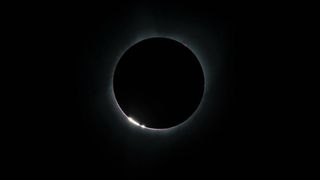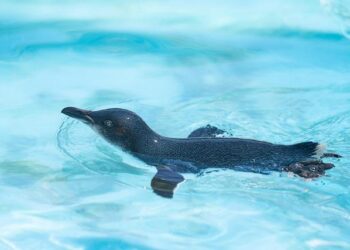
The Baily’s Beads effect as seen from Madras, Oregon, during the Aug. 21, 2017, total solar eclipse.
(Image credit: NASA/Aubrey Gemignani)
If you plan to watch the solar eclipse April 8 at the edge of the totality path, you might want to move further into the shadow.
New amateur calculations of the solar eclipse path suggest that variations in the local terrain might change if you see a total eclipse, or how long the eclipse is experienced, compared to older estimates. The work, first reported in Forbes, is not peer-reviewed, however. So take the findings with a dose of caution.
The next solar eclipse will happen in parts of the United States, Mexico and Canada. An eclipse of the sun happens when the moon passes in front of our solar neighbor. Because the moon is so small, its shadow is narrow indeed and that means totality may only last a few seconds, or minutes, in a tiny part of the Earth’s surface.
Related: April 8 total solar eclipse could bring uptick in fatal car crashes, scientists caution
Amateur John Irwin, on the Besselian Elements website, re-examined the eclipse path with “adjustments that account for the topographic elevation, both around the limb of the moon and on the surface of the Earth.”
While you can click on the embedded map to see the details, Forbes identified 15 areas that may see some differences of the eclipse totality path.
On their Facebook page, the Besselian team describes themselves as “a team of dedicated amateur astronomers, passionate about solar eclipses”, which means their work hasn’t been fact-checked by scientists as you’ll see in areas like professional journal publications.
Breaking space news, the latest updates on rocket launches, skywatching events and more!
EarthSky, another astronomy publication, asked C. Alex Young, associate director for Science in the heliophysics science division of NASA Goddard Spaceflight Center, about the new findings.
Young didn’t explicitly endorse Besselian’s work, but said he will have a peer-reviewed paper coming out shortly showing the sun is slightly larger than expected. He told EarthSky that finding was uncovered during a previous U.S. total solar eclipse in 2017. That work, he added, may influence future eclipse mappings.
If you’re looking for a takeaway solution, the best idea is to move as far into the region of shadow as you can to avoid any hiccups. And when you’re observing the solar eclipse, make sure you have the right tools to do so.
Our guide on how to observe the sun safely guide tells you what you need to know to look at the sun. We also have a guide to solar eclipse glasses, and how to safely photograph the sun if you’d like to get practicing before the big day.
Join our Space Forums to keep talking space on the latest missions, night sky and more! And if you have a news tip, correction or comment, let us know at: [email protected].
Elizabeth Howell (she/her), Ph.D., is a staff writer in the spaceflight channel since 2022 covering diversity, education and gaming as well. She was contributing writer for Space.com for 10 years before joining full-time. Elizabeth’s reporting includes multiple exclusives with the White House and Office of the Vice-President of the United States, an exclusive conversation with aspiring space tourist (and NSYNC bassist) Lance Bass, speaking several times with the International Space Station, witnessing five human spaceflight launches on two continents, flying parabolic, working inside a spacesuit, and participating in a simulated Mars mission. Her latest book, “Why Am I Taller?”, is co-written with astronaut Dave Williams. Elizabeth holds a Ph.D. and M.Sc. in Space Studies from the University of North Dakota, a Bachelor of Journalism from Canada’s Carleton University and a Bachelor of History from Canada’s Athabasca University. Elizabeth is also a post-secondary instructor in communications and science at several institutions since 2015; her experience includes developing and teaching an astronomy course at Canada’s Algonquin College (with Indigenous content as well) to more than 1,000 students since 2020. Elizabeth first got interested in space after watching the movie Apollo 13 in 1996, and still wants to be an astronaut someday. Mastodon: https://qoto.org/@howellspace
>>> Read full article>>>
Copyright for syndicated content belongs to the linked Source : Space.com – https://www.space.com/solar-eclipse-sights-variable-shadow-edge-report































